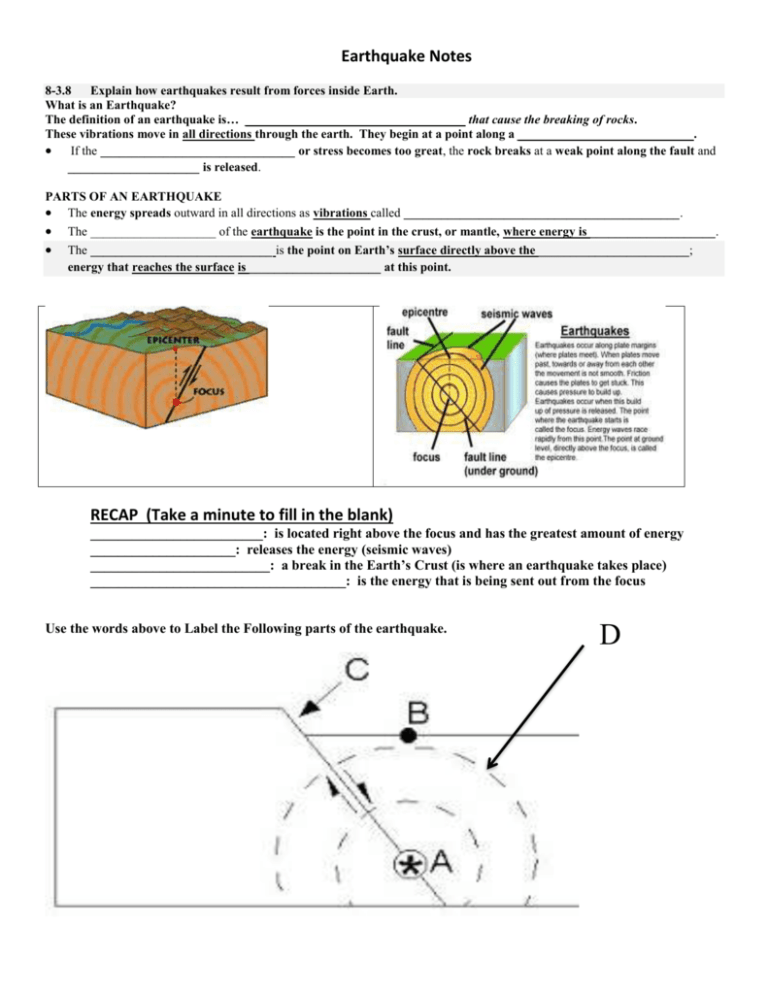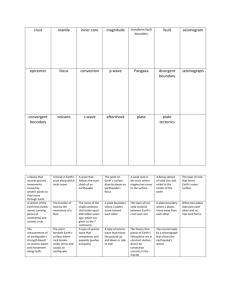Earthquake Notes: Seismic Waves, Epicenter, and More
advertisement

Earthquake Notes 8-3.8 Explain how earthquakes result from forces inside Earth. What is an Earthquake? The definition of an earthquake is… ___________________________________ that cause the breaking of rocks. These vibrations move in all directions through the earth. They begin at a point along a ____________________________. If the _______________________________ or stress becomes too great, the rock breaks at a weak point along the fault and _____________________ is released. PARTS OF AN EARTHQUAKE The energy spreads outward in all directions as vibrations called ____________________________________________. The ____________________ of the earthquake is the point in the crust, or mantle, where energy is ____________________. The _____________________________ is the point on Earth’s surface directly above the ________________________; energy that reaches the surface is _____________________ at this point. RECAP (Take a minute to fill in the blank) _________________________: is located right above the focus and has the greatest amount of energy _____________________: releases the energy (seismic waves) __________________________: a break in the Earth’s Crust (is where an earthquake takes place) _____________________________________: is the energy that is being sent out from the focus Use the words above to Label the Following parts of the earthquake. D 8-3.2 Explain how scientists use seismic waves – primary, secondary, and surface waves – and Earth’s magnetic fields to determine the internal structure of Earth. Seismic Waves: There are 3 types of seismic waves: ______________________________________________________ • _SEISMIC WAVES___ are waves generated by an earthquake that travel through the Earth. These waves can cause the ground to move forward, backward, up, down, and even to ripple. Seismic Waves are generated at the ____________________________ time but move in different ways, and at different speeds. Seismic Waves Scientists use the principle that the ______________________________________________ of a seismic wave depends on the material it travels through. How does scientist know or study the Earth’s Core? Because of the behavior of these different waves, scientists have indirect evidence for the solid inner core and liquid outer core of Earth because ______________________________ don’t travel through the outer core because it’s a __________________________. Also because earthquake waves travel faster through the mantle than through the crust, scientists know that the mantle is denser than the crust. Types of Seismic Waves Primary Waves (P Waves) Secondary Waves (S Waves) Surface Waves Movement/Description Travels Through _______________ Wave to Move out from the earthquake focus, the point where the energy is released Travel the _____________ of the three waves Push and pull rock creating a back-and-forth motion in the direction the wave is moving (known as longitudinal or compressional waves) ________wave to Move out from the earthquake focus Move ________________ than primary waves Move at ________________ to primary waves causing rocks to move up and down and side to side (known as __________________ wave: perpendicular to the wave motion) Move through solid and liquid layers of Earth (therefore it can move through ___________ layers) Move through solid and liquid layers of Earth (therefore it can move through ______________layers) Form when P and S waves reach the surface ________________________ ________________________ Can cause the ground to shake making rock sway from side to side and roll like an ocean wave Can only move through ________________ rock therefore it CAN NOT TRAVEL THROUGH THE ________________ because it is a ____________. IT __________ AT THE OUTER CORE. Illustration 8-3.3 Infer an earthquake’s epicenter from seismographic data. The energy spreads outward in all directions as vibrations called __________________________________. Seismic waves can be measured and recorded by a ______________________________________. The vibration record, called a ___________________________________, looks like jagged lines on paper. Measuring the time between the arrival of the P and S waves determines the _______________________between the recording seismograph and the earthquake epicenter. SEISMOGRAPH SEISMOGRAM How to find the S-P INTERVALS To find the S-P intervals, you have to _________________ the ____________ Wave from the _________Wave. Measuring the time between the arrival of the P and S waves determines the distance between the recording seismograph and the earthquake epicenter. Find the S-P interval: Show your steps. What are the S-P Intervals? ___________ What are the S-P Intervals? ___________ ___________________________________ identifies the ____________________________ of an earthquake. The location of an earthquake’s epicenter is found by plotting ___________________________ on a map from the records of three seismograph stations and finding the point where the three circles _________________________. Note where the 3 circles meet is where the _________________________________ is located. MONDAY HW Answer the Following Questions. (8-3.8) 1. The order of seismic waves leaving from the focus is __________. a. P-wave, S-wave, Surface Wave b. P-wave, Surface Wave, S-wave c. S-wave, Surface Wave, P-wave d. Surface Wave, P-wave, S-wave 2. How do you identify the process triangulation? 3. The process triangulation is used to find what? 4. What is the difference between a seismograph and a seismogram? 5. Explain 3 differences between the P and S waves. TUESDAY HW 1. Where is the greatest amount of energy being released on the surface? 2. The energy of an earthquake is called? 3. Earthquakes happen along what? 4. Where is energy being released during an earthquake? 5. What is the most destructive seismic wave and when does it occurs? WEDNESDAY HW STUDY FOR QUIZ







